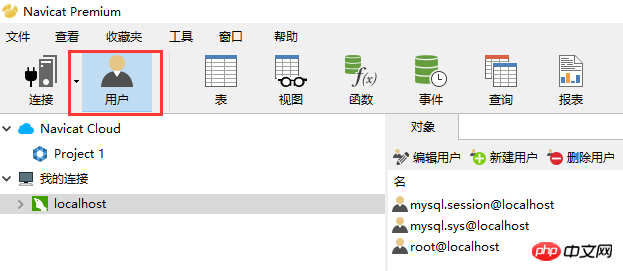How to set database operation permissions in Navicat
In order to reduce developers' erroneous operations, permissions can be set for control. The goal is achieved by creating different users for the MySQL server and granting different permissions to the users. This article will introduce to you how to set the operating permissions of the Navicat database. Friends in need can refer to it.
The following content is the detailed setting steps.
1. Create a new user
1. Use Navicat to connect to the local server (if you have connected before, please open the connection)
2. Click on the menu bar –> User, as shown in the picture:

3. Click to create a new user, as shown in the picture below:

Username: Set the username to connect to the server
Host: Set the host IP address that is allowed to connect to the server. %, means that this user can connect to the server on all hosts; 192.168.21.*, means that this user can only connect to the server on hosts whose IP address belongs to segment 21; 192.168.21.88, means that this user can only connect to the server on IP addresses of 192.168 Connect to the server on the host of .21.88.
Password: Set the password to connect to the server
Confirm password: Keep it consistent with the password setting
2. Permission settings
Such as As shown in the picture above, we can see that there are other tab items: Advanced, Server Permissions, Permissions and SQL Preview.
Advanced: You can set the maximum number of queries/maximum updates/maximum connections/maximum user connections per hour and SSL for this user.
Server permissions: Set operation permissions for all databases on the server.
Permissions: Set permissions for specific libraries and specific tables. When conflicting with server permission settings, the server permissions shall prevail.
SQL preview: All the SQL statements set above will be displayed here.
For the meaning of server permissions and permissions tab settings, please refer to the permission description below.
3. Permission Description

4. MySQL Permissions Experience Principles
Permissions Control is mainly for security reasons, so the following empirical principles need to be followed:
1. Only grant the minimum permissions that meet the needs to prevent users from misoperation or intentional sabotage operations.
2. When creating a user, limit the user’s login host, usually to a specified IP or intranet IP segment.
3. Delete users without passwords when initializing the database. After installing the database, some users will be automatically created. These users will have no passwords by default.
4. Set a password that meets the password complexity for each user.
5. Regularly clean up unnecessary users. Reclaim permissions or delete users.
Conclusion
The most efficient way to learn a new knowledge is to read official documents. Most of the other learning materials on the Internet have been processed, and processed in a bad direction. Otherwise, people follow what others say and lead people astray. However, many times I have to learn from the Internet, because most of the official documents are in English, which is really difficult to read. At this time, I discovered that being able to read English documents easily is a very valuable skill.
The above is the detailed content of How to set database operation permissions in Navicat. For more information, please follow other related articles on the PHP Chinese website!

Hot AI Tools

Undresser.AI Undress
AI-powered app for creating realistic nude photos

AI Clothes Remover
Online AI tool for removing clothes from photos.

Undress AI Tool
Undress images for free

Clothoff.io
AI clothes remover

Video Face Swap
Swap faces in any video effortlessly with our completely free AI face swap tool!

Hot Article

Hot Tools

Notepad++7.3.1
Easy-to-use and free code editor

SublimeText3 Chinese version
Chinese version, very easy to use

Zend Studio 13.0.1
Powerful PHP integrated development environment

Dreamweaver CS6
Visual web development tools

SublimeText3 Mac version
God-level code editing software (SublimeText3)

Hot Topics
 1393
1393
 52
52
 1209
1209
 24
24
 MySQL: An Introduction to the World's Most Popular Database
Apr 12, 2025 am 12:18 AM
MySQL: An Introduction to the World's Most Popular Database
Apr 12, 2025 am 12:18 AM
MySQL is an open source relational database management system, mainly used to store and retrieve data quickly and reliably. Its working principle includes client requests, query resolution, execution of queries and return results. Examples of usage include creating tables, inserting and querying data, and advanced features such as JOIN operations. Common errors involve SQL syntax, data types, and permissions, and optimization suggestions include the use of indexes, optimized queries, and partitioning of tables.
 MySQL's Place: Databases and Programming
Apr 13, 2025 am 12:18 AM
MySQL's Place: Databases and Programming
Apr 13, 2025 am 12:18 AM
MySQL's position in databases and programming is very important. It is an open source relational database management system that is widely used in various application scenarios. 1) MySQL provides efficient data storage, organization and retrieval functions, supporting Web, mobile and enterprise-level systems. 2) It uses a client-server architecture, supports multiple storage engines and index optimization. 3) Basic usages include creating tables and inserting data, and advanced usages involve multi-table JOINs and complex queries. 4) Frequently asked questions such as SQL syntax errors and performance issues can be debugged through the EXPLAIN command and slow query log. 5) Performance optimization methods include rational use of indexes, optimized query and use of caches. Best practices include using transactions and PreparedStatemen
 Why Use MySQL? Benefits and Advantages
Apr 12, 2025 am 12:17 AM
Why Use MySQL? Benefits and Advantages
Apr 12, 2025 am 12:17 AM
MySQL is chosen for its performance, reliability, ease of use, and community support. 1.MySQL provides efficient data storage and retrieval functions, supporting multiple data types and advanced query operations. 2. Adopt client-server architecture and multiple storage engines to support transaction and query optimization. 3. Easy to use, supports a variety of operating systems and programming languages. 4. Have strong community support and provide rich resources and solutions.
 How to connect to the database of apache
Apr 13, 2025 pm 01:03 PM
How to connect to the database of apache
Apr 13, 2025 pm 01:03 PM
Apache connects to a database requires the following steps: Install the database driver. Configure the web.xml file to create a connection pool. Create a JDBC data source and specify the connection settings. Use the JDBC API to access the database from Java code, including getting connections, creating statements, binding parameters, executing queries or updates, and processing results.
 How to start mysql by docker
Apr 15, 2025 pm 12:09 PM
How to start mysql by docker
Apr 15, 2025 pm 12:09 PM
The process of starting MySQL in Docker consists of the following steps: Pull the MySQL image to create and start the container, set the root user password, and map the port verification connection Create the database and the user grants all permissions to the database
 Centos install mysql
Apr 14, 2025 pm 08:09 PM
Centos install mysql
Apr 14, 2025 pm 08:09 PM
Installing MySQL on CentOS involves the following steps: Adding the appropriate MySQL yum source. Execute the yum install mysql-server command to install the MySQL server. Use the mysql_secure_installation command to make security settings, such as setting the root user password. Customize the MySQL configuration file as needed. Tune MySQL parameters and optimize databases for performance.
 MySQL's Role: Databases in Web Applications
Apr 17, 2025 am 12:23 AM
MySQL's Role: Databases in Web Applications
Apr 17, 2025 am 12:23 AM
The main role of MySQL in web applications is to store and manage data. 1.MySQL efficiently processes user information, product catalogs, transaction records and other data. 2. Through SQL query, developers can extract information from the database to generate dynamic content. 3.MySQL works based on the client-server model to ensure acceptable query speed.
 How to install mysql in centos7
Apr 14, 2025 pm 08:30 PM
How to install mysql in centos7
Apr 14, 2025 pm 08:30 PM
The key to installing MySQL elegantly is to add the official MySQL repository. The specific steps are as follows: Download the MySQL official GPG key to prevent phishing attacks. Add MySQL repository file: rpm -Uvh https://dev.mysql.com/get/mysql80-community-release-el7-3.noarch.rpm Update yum repository cache: yum update installation MySQL: yum install mysql-server startup MySQL service: systemctl start mysqld set up booting




